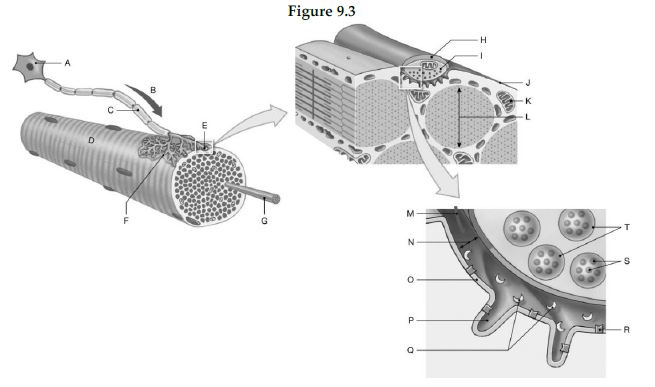Using the figure below, identify the labeled part.

1) Label A: ______________________________
2) Label B: ______________________________
3) Label C: ______________________________
4) Label D: ______________________________
5) Label E: ______________________________
6) Label F: ______________________________
7) Label G: ______________________________
8) Label H: ______________________________
9) Label I: ______________________________
10) Label J: ______________________________
11) Label K: ______________________________
12) Label L: ______________________________
13) Label M: ______________________________
14) Label N: ______________________________
15) Label O: ______________________________
16) Label P: ______________________________
17) Label Q: ______________________________
18) Label R: ______________________________
19) Label S: ______________________________
20) Label T: ______________________________
1) Motor neuron
2) Path of action potential
3) Axon
4) Muscle fiber
5) Neuromuscular synapse
6) Motor end plate
7) Myofibril
8) Glial cell
9) Synaptic terminal
10) Sarcolemma
11) Mitochondrion
12) Myofibril
13) Arriving action potential
14) Synaptic cleft
15) Sarcolemma of motor end plate
16) Junctional fluid
17) AChE molecules
18) ACh receptor site
19) ACh
20) Synaptic vesicles
You might also like to view...
Match each term with its definition or description.
a. zygote b. morula c. blastocyst d. placenta e. fetus f. embryo g. ectoderm h. mesoderm i. endoderm j. histogenesis k. amniotic cavity l. implantation m. organogenesis n. fertilization o. yolk sac 1. _____ Connecting “bridge” between mother and baby 2. _____ Term used to describe the developing baby during the first 8 weeks 3. _____ Term used for the fertilized egg 4. _____ Term used to describe the development of tissues 5. _____ Term used to describe the developing baby from week 9 to week 39 6. _____ Term for the solid mass of cells formed by the fertilized egg about three days after fertilization 7. _____ Primary germ layer that forms the lining of the gastrointestinal tract 8. _____ Term for the hollow ball of cells the fertilized egg has formed by the time it reaches the uterus 9. _____ Primary germ layer that forms the brain and spinal cord 10. _____ Primary germ layer that forms muscles 11. _____ Moment when the ova and sperm unite 12. _____ Embedding of the blastocyst into the uterine wall 13. _____ Source of nutrients in birds, but produces blood cells in humans 14. _____ Fluid-filled shock-absorbing sac sometimes called the bag of waters 15. _____ Process by which tissues arrange themselves into organs
Cynthia has received her lab results and is told that her blood calcium levels are abnormal. The event in neuron transmission that would most likely be affected would be:
a. summation of graded potentials in the initial segment. b. production of graded potentials in the dendrites and cell body. c. release of neurotransmitter from the synaptic knob. d. propagation of an action potential in the axon.
These facial bones increase the ability of the nasal passageways to warm and humidify incoming air
A) maxillae B) inferior nasal conchae C) ethmoids D) nasal
Which treatment plan may involve a recommendation to eat healthy and exercise regularly?
A. Preventive B. Curative C. Therapeutic D. Palliative